“Would You Like some Film Packs?”
A friend here in town is an experienced and very capable photographer with over six decades of experience. Early this year (2020), his wife emailed me wondering if I would like a couple of his film packs because they wanted to make space in the freezer. I thought, film packs? I had not used one since the early 1970s. They still exist? Come to find out, a couple meant an entire cooler full, and my friend had stored them in various freezers since the late 1960s! Well, this sounded like a photographic adventure, so I graciously accepted this generous gift.
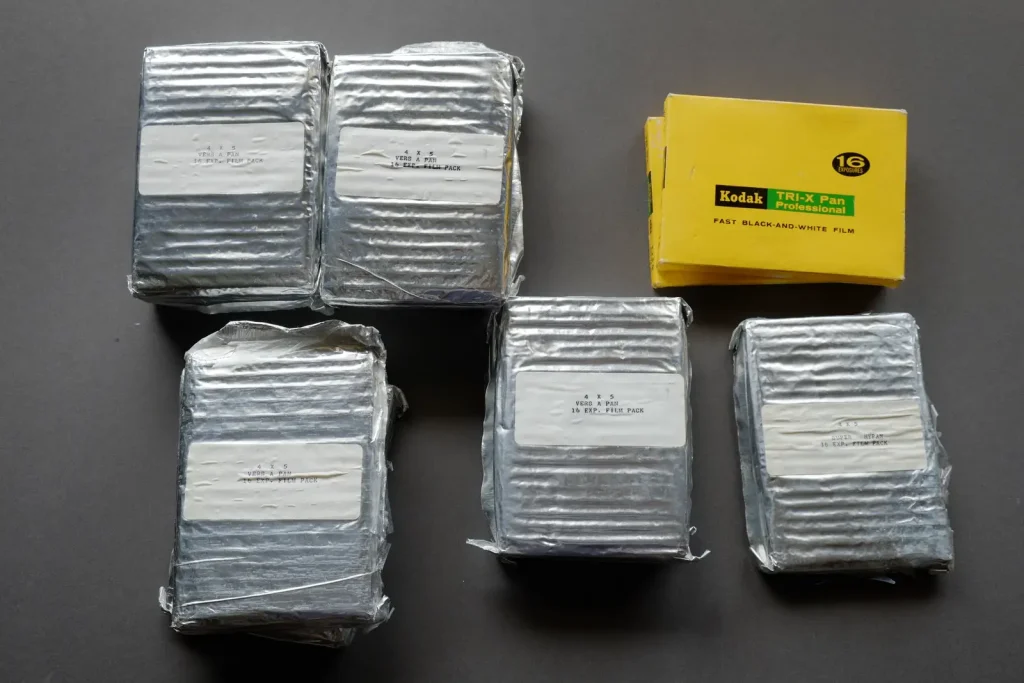
What is a Film Pack?
A film pack is a metal box which holds 16 sheets of thin-based 4×5 inch film. Each sheet is attached to a numbered black paper tab. The metal box is placed in a film pack adapter. My friend gave me an adapter made by the American company Graphic (see the first photograph). The user starts the film pack by pulling and then tearing off the initial tab of black paper. Then frame no. 1 is ready to use. Focus and compose your 4×5 camera as normal, and then insert the Graphic adapter. Pull the dark slide and take exposure no. 1. Then carefully pull the tab, and that first sheet of film pulls under the rest of the stack to the back of the group.
This makes sheet no. 2 exposed on the front and ready to use. In the photographs below, I have shown the handsome red metal film pack in the adapter and well as one of the 4×5 sheets pulled partway. When you expose sheet 16, you pull the tab and you have finished the pack. You can then remove the metal from the adapter in subdued daylight. The film manufacturers warn you to not press on the exposed black paper shield because then you risk a light leak. The pack adapter is a bit thicker then a normal Fidelity or Lisco sheet film holder but should fit under the ground glass of most brands of cameras.
According to Camera-wiki, Eastman Kodak introduced the film pack in 1903. Over time, at least 12 film sizes were sold, and possibly European manufacturers offered even more. My earlier experience in the 1970s was with 2¼×3¼” film pack in an old Certo Sport camera. I do not remember how many sheets were in that size pack. The most popular size may have been 4×5″ because the old time press reporters could take 16 quick exposures with their Speed Graphic cameras at a news event. Then they could pop another pack in the adapter and take another 16 frames. I read somewhere that Kodak finally discontinued their 4×5″ film packs around 1992 when the last technician who knew how to assemble the packs retired. By then, most of the demand was gone because press/wedding photographers were using medium format or 35mm cameras.
The film pack lingered on in modified form to hold Polaroid instant films. Fuji’s Instax film is a form of film pack.
The main criticism of the film pack was that the film was thin and too flexible. Darkroom users needed to mount the thin film on glass negative holders. With respect to scanning, in my limited experience, the film will lie in the 4×5″ holder of my Epson scanner with minimal sagging. Some companies sell holders with anti-Newton glass to ensure that the film would be absolutely flat. Regular 4×5″ film is on a much thicker base and does not sag. The film pack film is a slightly different size then normal 4×5, so you need to trim it to fit normal scanner film holders.
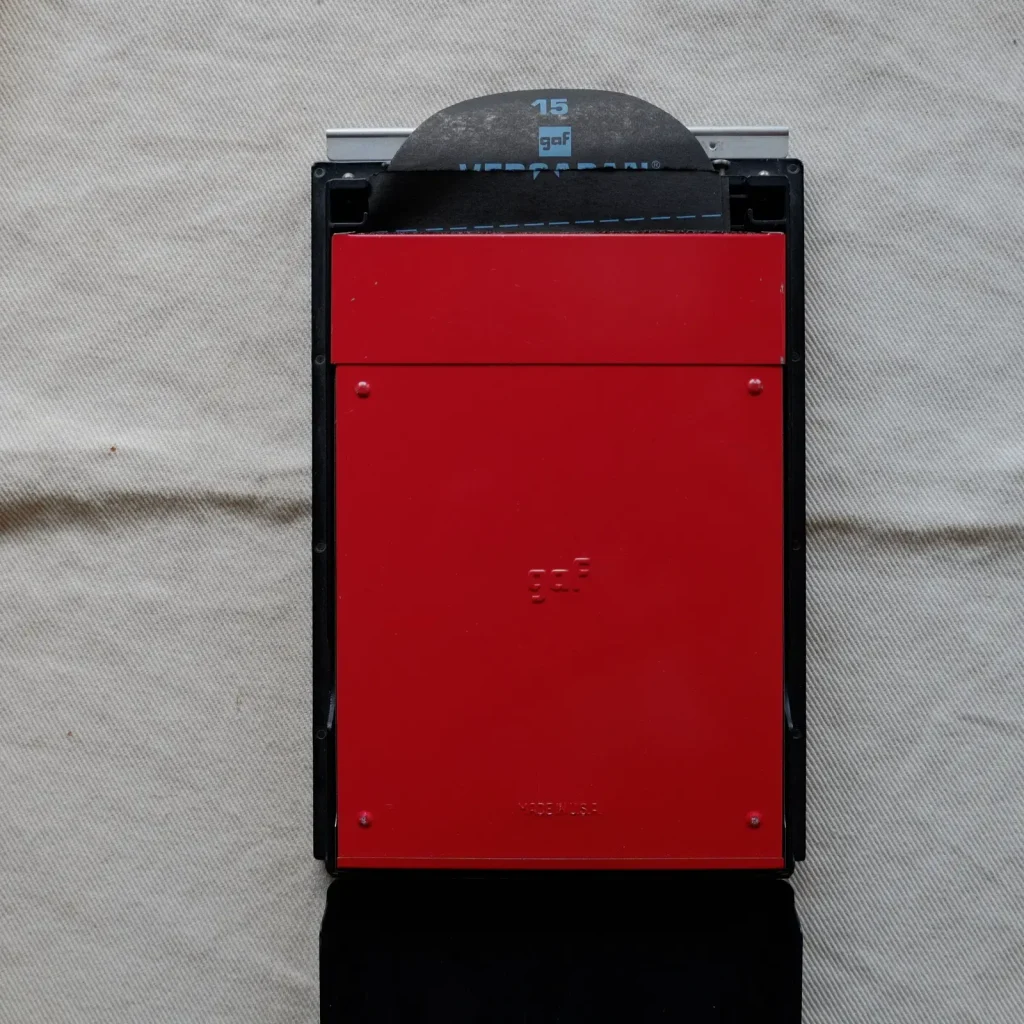
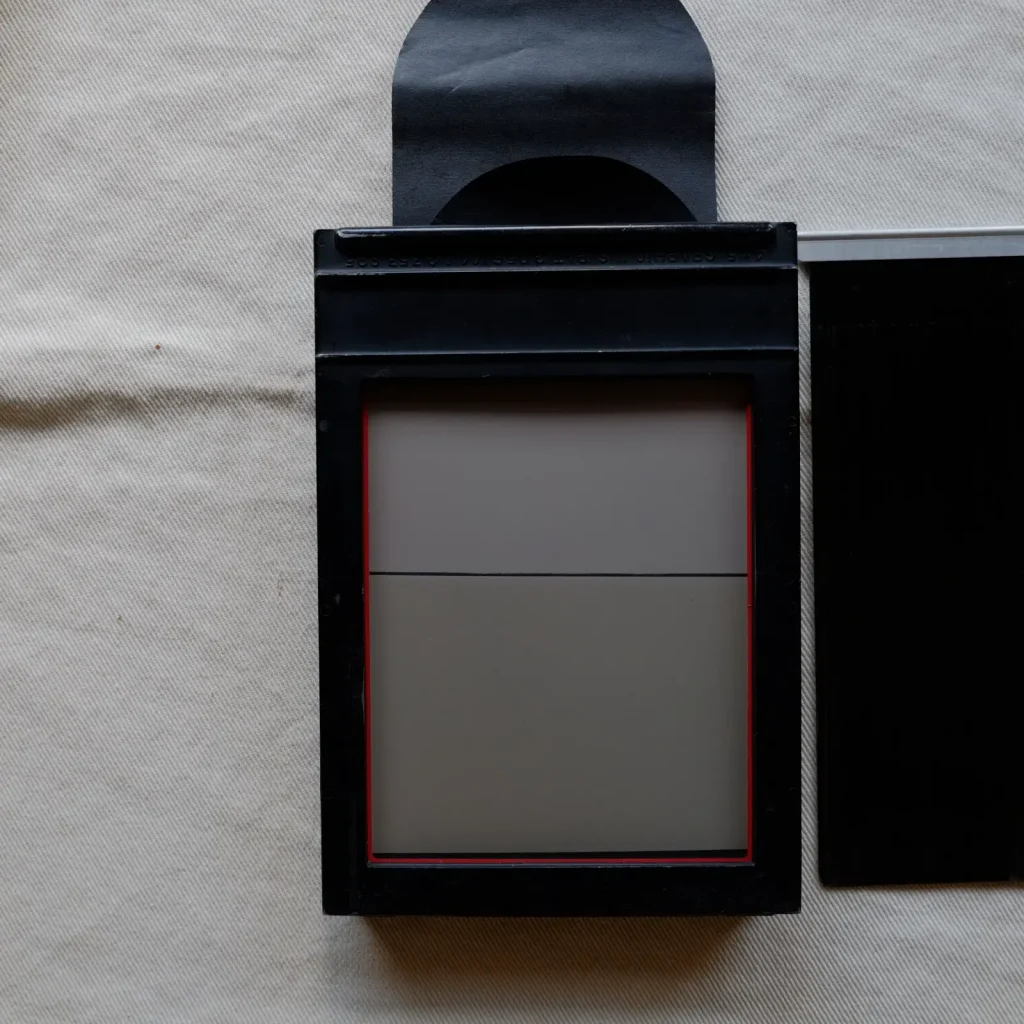
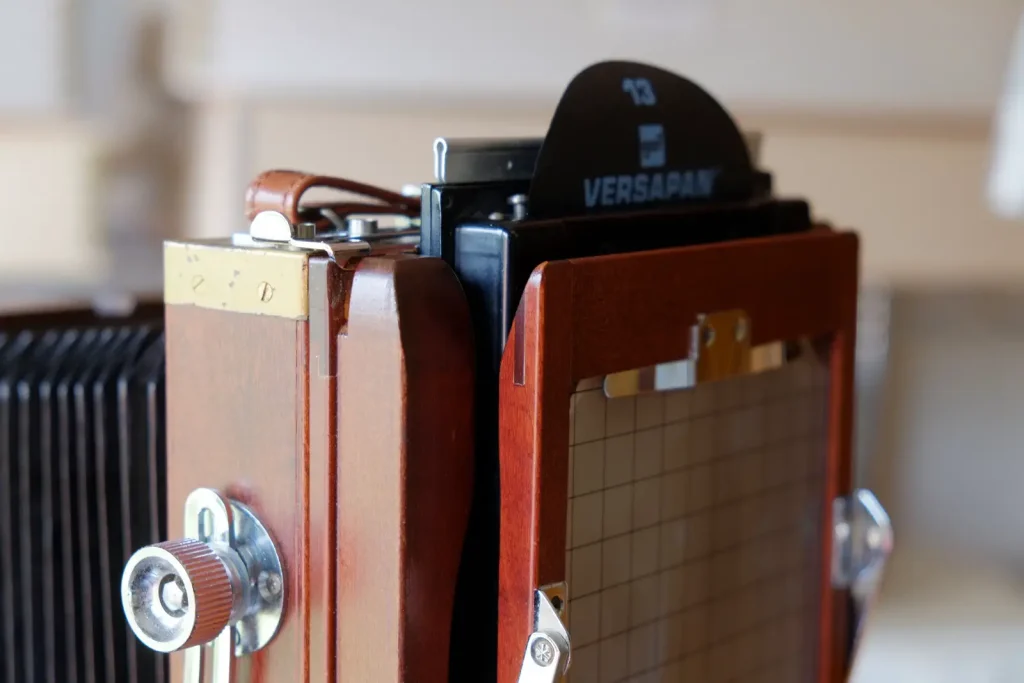
GAF and Ansco Film
Ansco was an American company founded in 1842. The company expanded into photographic products in 1847 and invented celluloid flexible roll film. Kodak used (stole) the technology and eventually lost a 12-year patent lawsuit to Ansco. As summarized in VintageCameraLab.com, the German film company, Agfa, merged with Ansco and renamed the new operation Agfa-Ansco. Agfa-Ansco thrived after the takeover, producing cameras, films, and photographic papers. Upon America’s entry in World War II, the U.S. Government seized Ansco’s operations as enemy property because of the German ownership and complicated association with the American IG Chemical Corporation (part of the IG Farben empire). During the war, production shifted to military optics like sextants and bomber sights, and the “Agfa-Ansco” brand was reverted to just “Ansco.”
After the war, Ansco remained under U.S. Government ownership and control until 1965, at which time it sold shares to the public. Post-war, Ansco thrived, selling 2 million cameras per year at its peak, as well as selling rebranded cameras from other manufacturers like Agfa, Ricoh, Chinon, and Minolta. In 1967, Ansco changed its name to General Aniline & Film (GAF), an old-line American company that was best known for roofing shingles but who also had a photographic products division. From the 1950s to the 1970s, Ansco/GAF was Eastman Kodak’s largest competitor in the US market. In 1977, GAF finally ended production of consumer films, although the manufacture of other films continued (I assume aerial photography, X-ray, and other industrial products).
Ansco offered some innovative products, including color films and the first ASA 500 slide film. Most of Ansco’s color products have not survived the years well and have suffered severe color shifts and fading. But photographers praised the black and white films. I tried to find information on the web about Versapan film but found very little. This is not surprising considering that it was discontinued at least 35 years ago. A few notes said it was an excellent product, but one needs to beware that the “good old days” often sound so good on internet forums. A Popular Science magazine from November, 1963, contained a short paragraph describing the new film. At that time, Versapan roll film was rated at ASA (American Standards Association) 125. A 1969 U.S. Army still photography manual list the cut film at a speed of 100.
Needless to say, with 40-year-old film, you are not sure how it will respond. Old film tends to lose sensitivity, so I decided to take triple exposures at EI (exposure index) = 64, 32, and 16. With a pack holding 16 sheets, this would give me five scenes with one extra frame left over from the pack.
The next challenge was developing the film. I do not have a darkroom any more and therefore could not use open trays. My Jobo 4×5 daylight kit is for regular thick-based film. After some inquiries, I sent it to a laboratory in Maine, where the owner developed the Versapan in Xtol using Jobo tanks. He reported that the film looked like new. I subsequently scanned the negatives with an Epson 3200 Photo scanner at 2400 dpi and cleaned minor blobs and scratches with Photoshop CS5.
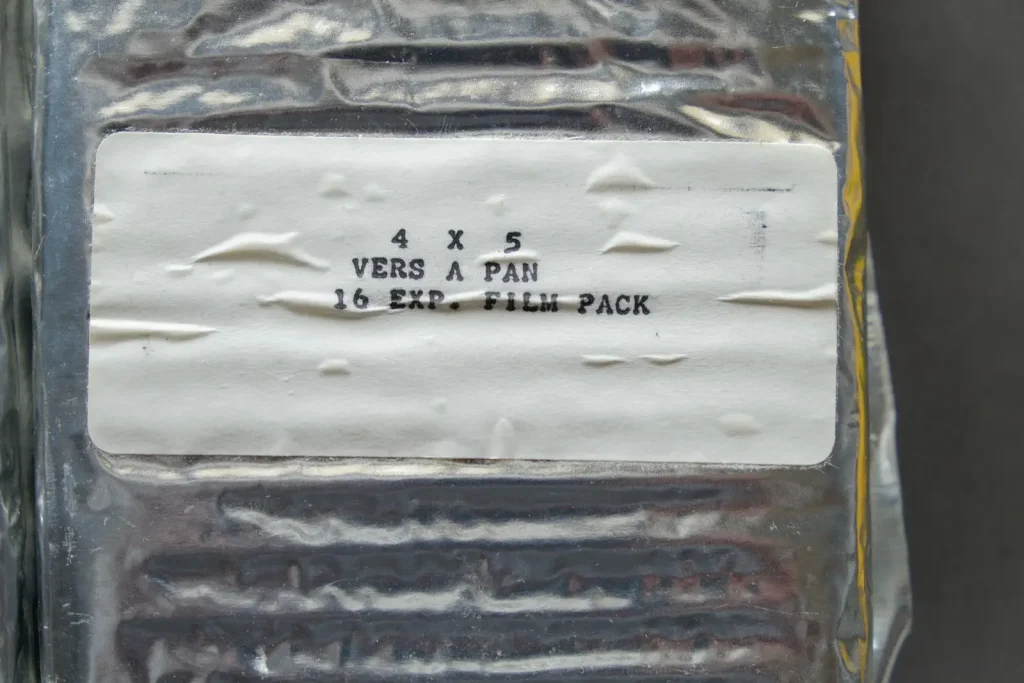
The Mississippi Delta
During our somewhat loose virus shutdown, I drove north into the Mississippi Delta several times to get out of the house, explore, use my Tachihara camera, and test the Versapan film. I like overcast days when the sky looks ominous and rain is pending. My first test was to compare the GAF Versapan with Kodak Tri-X Professional film. In the example of an old store below in Yazoo City, Mississippi, the first frame is from Tri-X while the second is Versapan. The Tri-X recorded a little more texture in the sky, but the contrast of one or the other could be adjusted during scanning. I certainly can’t claim that one is “better” than the other. The Versapan is fine grain and records fine detail. Remember, this film is over four decades old.
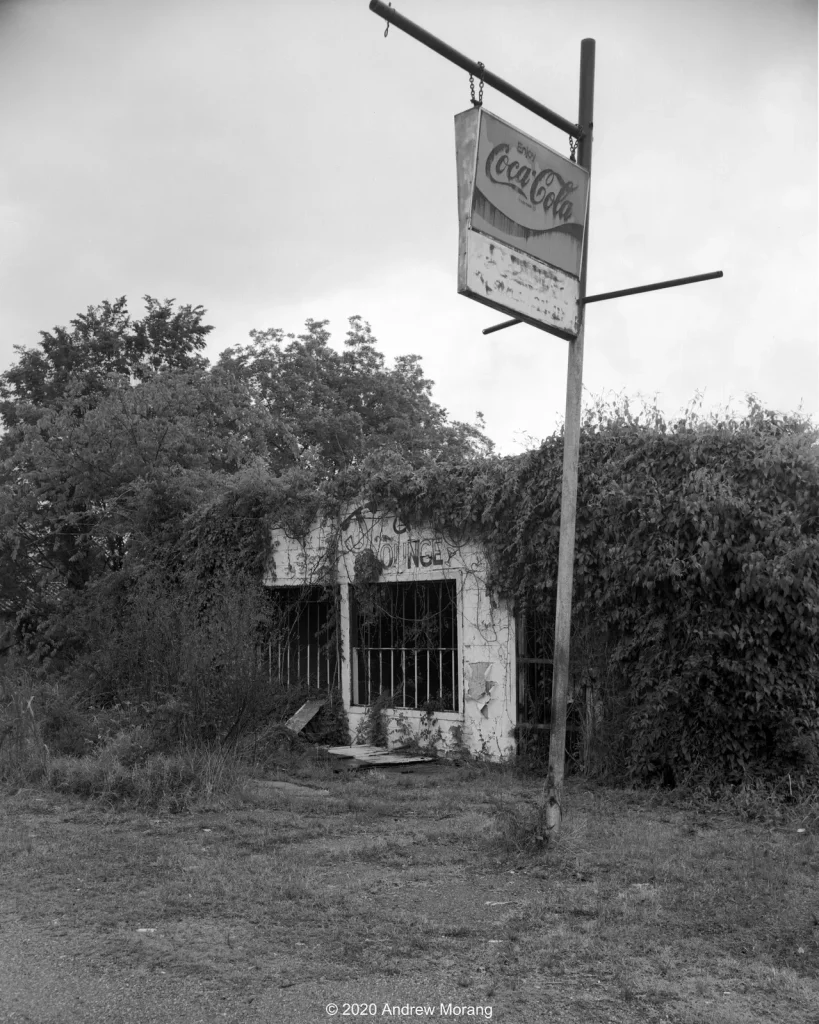
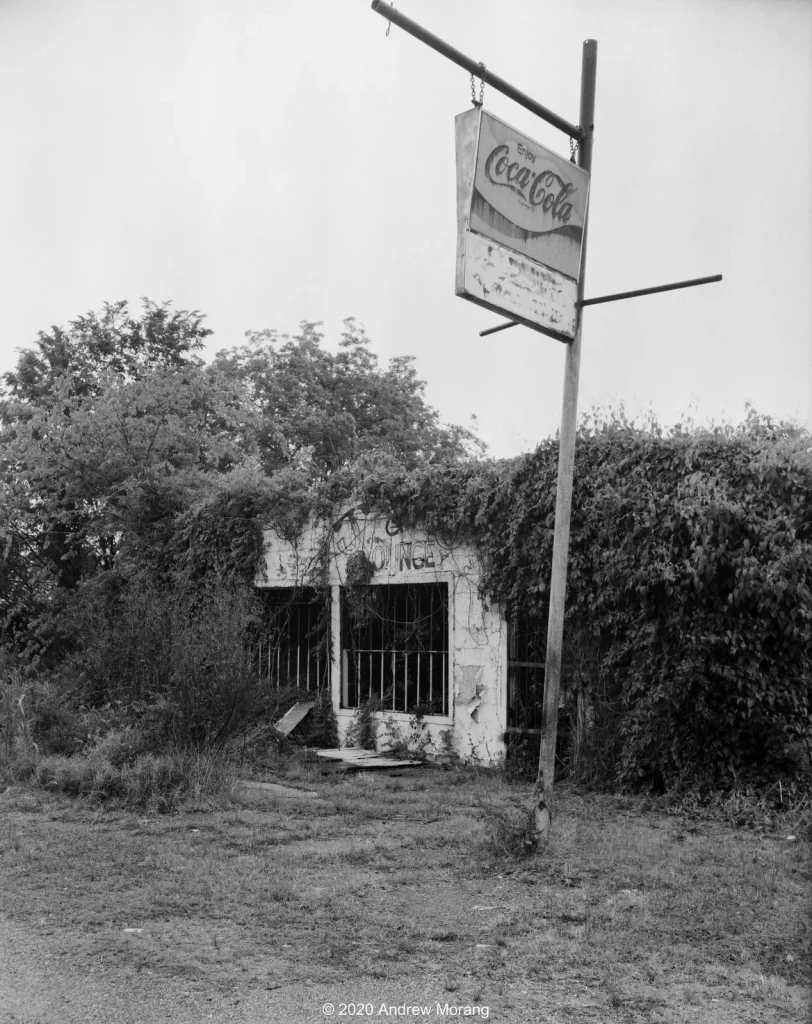
The petroleum tank farm in Yazoo City let me check the ability of the film to record the dark tank cars as well as the clouds. It passed with flying colors! This was a gloomy day with spitting rain on and off. I cropped the center section to show the painted signs on the rail cars. The grain is tight.
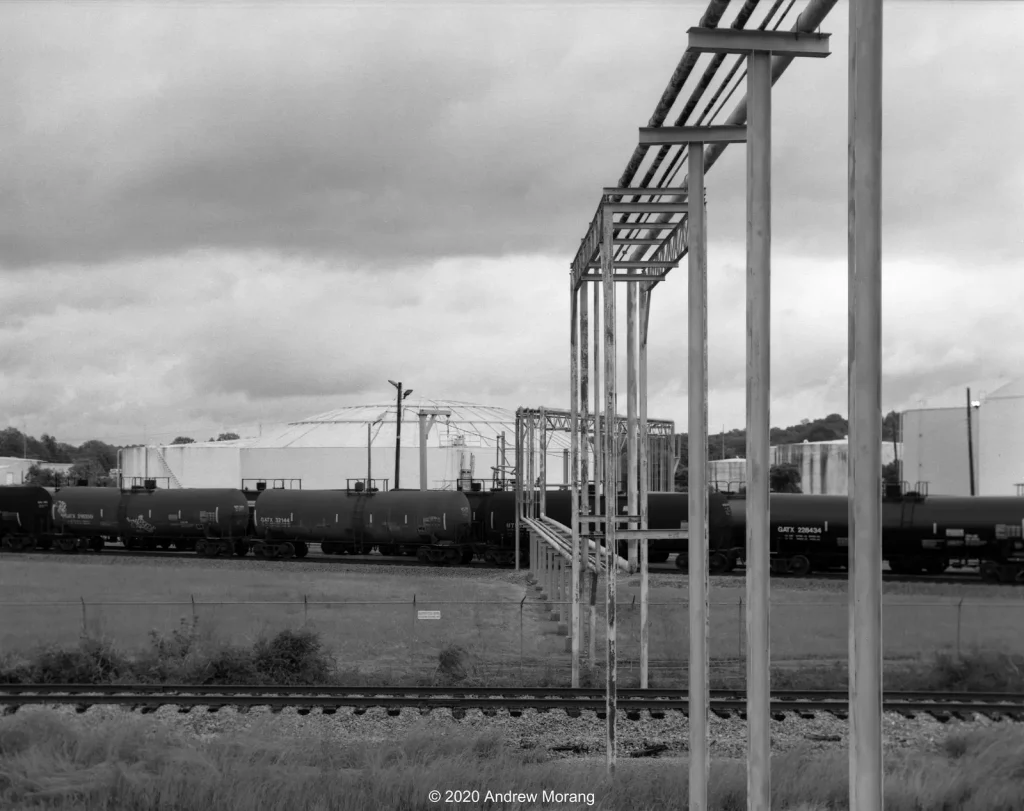
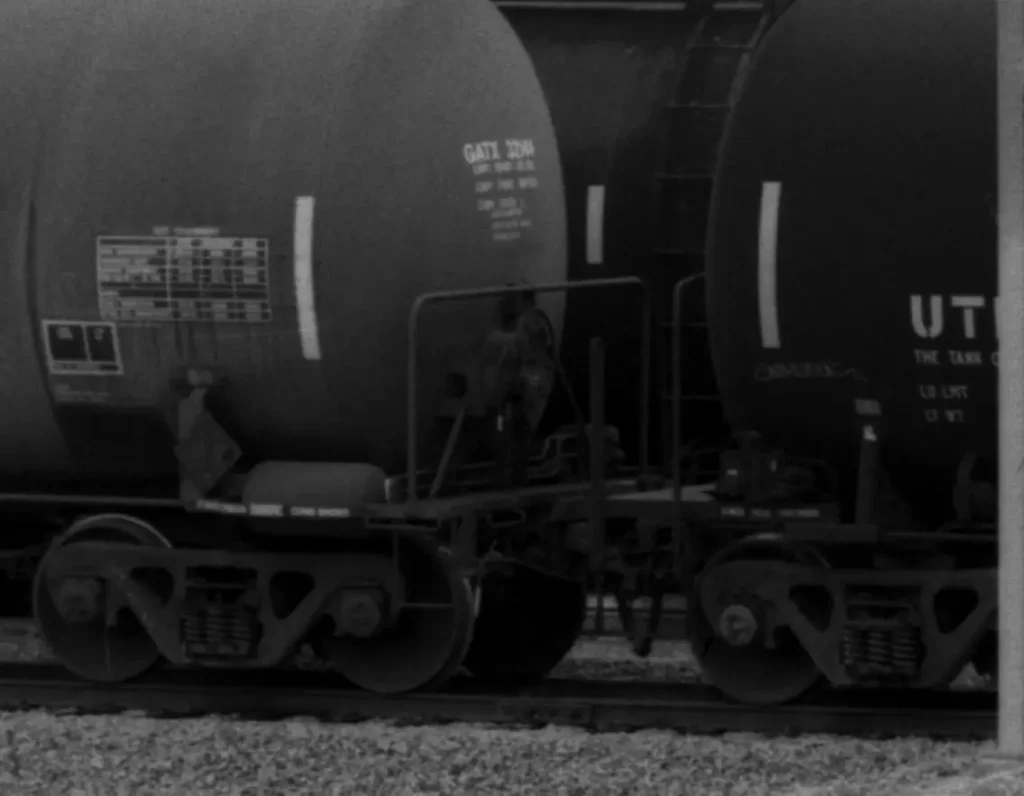
The little town of Midnight had an unused cotton gin with interesting shapes and textures. Many gins are unused now because farmers have shifted to soybeans or corn.
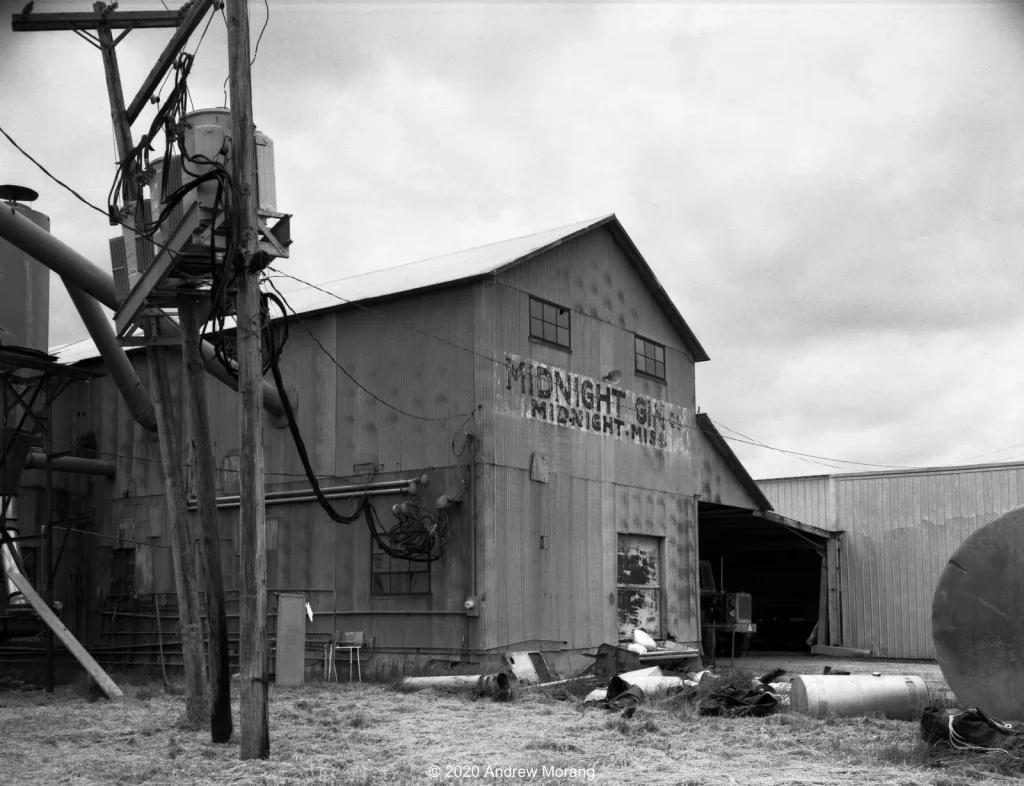
By the time I reached Holly Bluff, the sun was beginning to break through the clouds. Some old storage silos glowed in the light. I think the Versapan does very well with metal and silver objects.
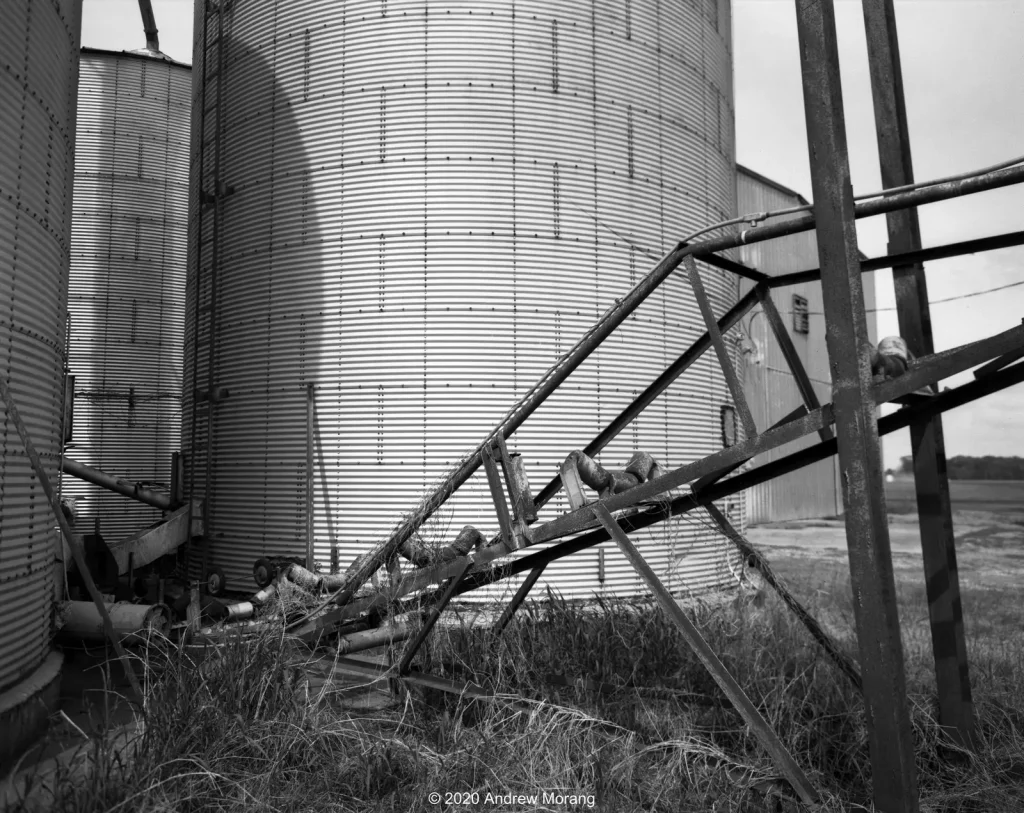
The photograph below is a nasty bayou (creek) which flows under one of Vicksburg’s streets. I used a green filter to help lighten the foliage. This is an example of a high-contrast scene where the Versapan did not retain detail in the light sky.
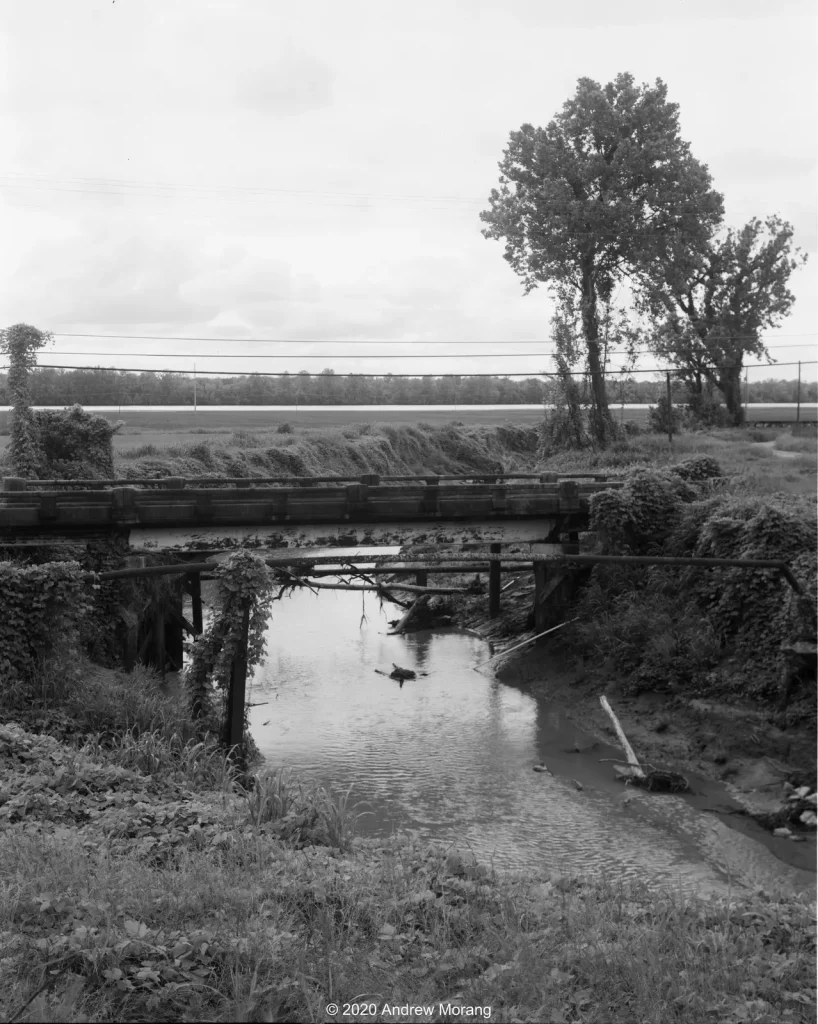
As a last example, here is an unused cotton gin in Ferriday, Louisiana. While I was taking this picture, a gent from the agricultural machinery company across the street came over to see my camera. He said the ladies in the office were most perplexed that someone was standing out in the 36 degree heat with a camera. He generously offered some cold water, a restroom, and some air conditioning. Southerners are very accommodating.
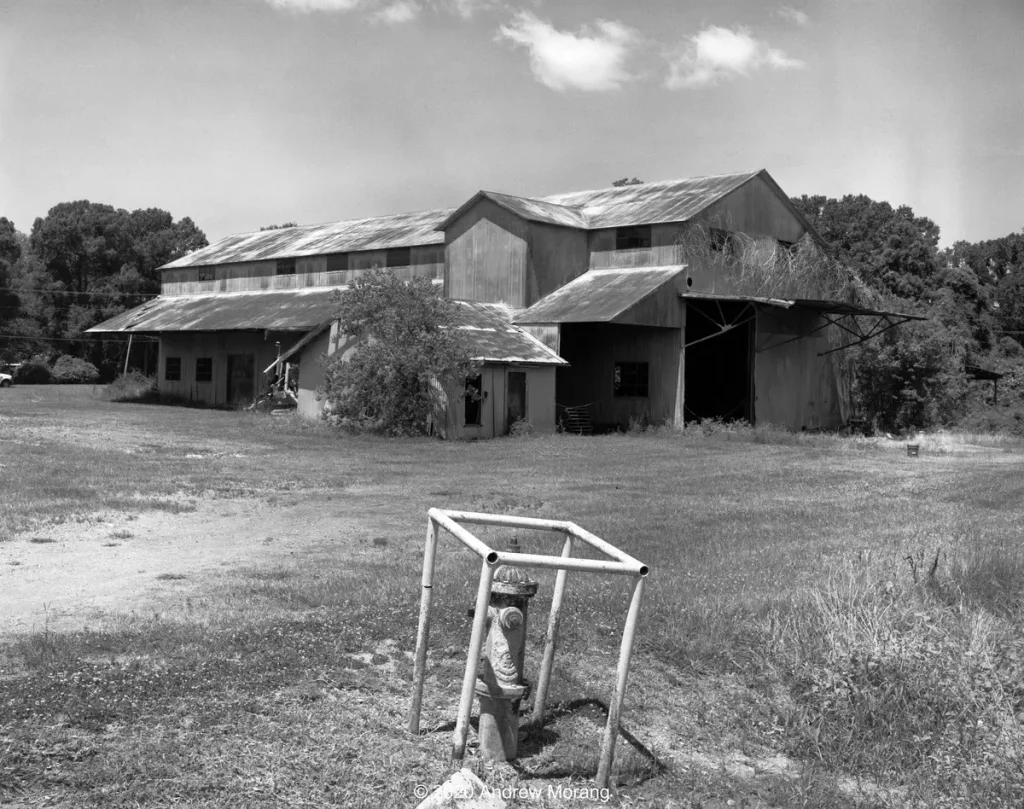
Some Concluding Remarks
Well, this was a pleasant surprise. Using a film pack on my 4×5″ camera took me back to an earlier time. I really liked the convenience of having 16 frames in one easy-to-change cartridge. With regular Fidelity or Lisco film holders, each one holds only 2 sheets, and I need to load them in a dark closet at night. For a long day’s outing, one can easily fill a cooler with holders (I mention cooler because it is hot here). But with three convenient and thin film packs, you have 48 sheets ready for a day’s use. The bad news: as far as I know, no one packages regular film (i.e., not instant) in film packs any more.
The second surprise: this thin-base Versapan is still viable and looks good – after five decades storage. Traditional silver gelatin emulsion is truly an amazing chemical and optical invention (but you 35mmc readers know this!). For most projects, I will continue to use Kodak Tri-X, but it is a nice option to have this “antique” Versapan available. I hope to post some more examples in the future here on 35mmc.
Thank you for reading. I have written about Tri-X 400 roll film here on 35mmc before. You can see more of my photography from the Mississippi Delta and other places on worldofdecay.blogspot.com. Stay well, record your world, and always explore.
Update Aug. 2020
For some more Versapan examples from the second film pack, please check here: https://worldofdecay.blogspot.com/2020/09/1960s-gaf-versapan-pack-film-more.html
Share this post:
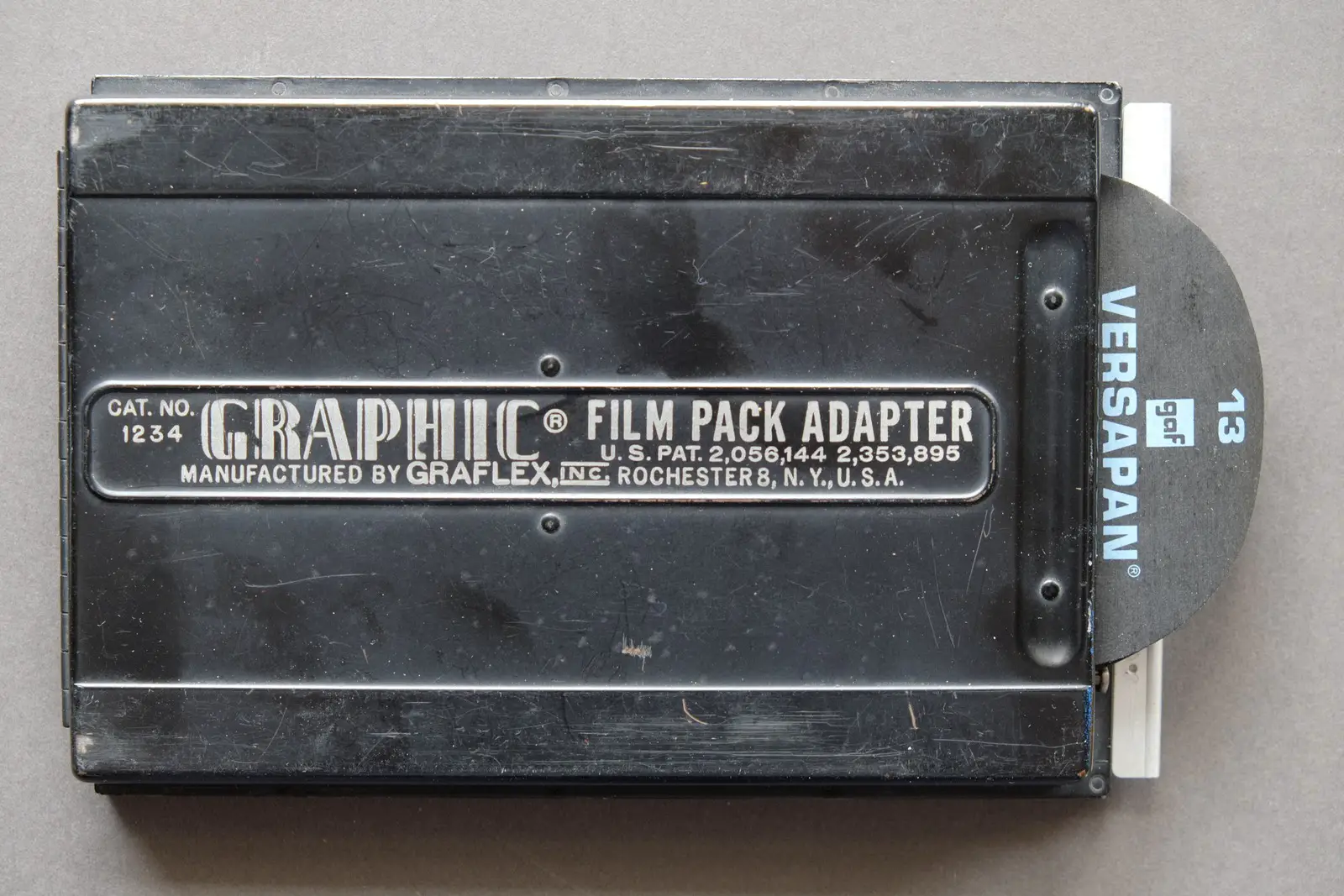








Comments
Howard Shubs on Shooting 4×5″ GAF Film Packs in the Mississippi Delta – by Andrew Morang
Comment posted: 31/07/2020
Comment posted: 31/07/2020
Terry B on Shooting 4×5″ GAF Film Packs in the Mississippi Delta – by Andrew Morang
Comment posted: 31/07/2020
Very impressive images from the old film, and your "urban decay" cycle, and I can well understand your surprise.
I've never heard of or read about Graflex film packs, possibly because I didn't get my first 5x4 until the early 1980's. But Graflex wasn't unknown to me as I soon acquired two of their Grafmatic 5x4 re-loadable cut sheet film backs, and which I'm sure you must know about. Just 6 shots per load, but still more convenient than 3x DDS. They also had a neat means to record frame numbers from 1 to 6, so the state of each was readily visible. My second unit was acquired relatively cheaply as this little feature wasn't working.
Not up to the 16-shot pack but still a useful advantage over the DDS's.
I couldn't quite get my head around the procedure to change each sheet in the 16 pack, it does seem to be a little nore complicated than the Grafmatic and which only requires a pull-push action to bring the next frame into position.
Comment posted: 31/07/2020
Comment posted: 31/07/2020
Russell Young F.R.P.S. on Shooting 4×5″ GAF Film Packs in the Mississippi Delta – by Andrew Morang
Comment posted: 31/07/2020
The article took me back to 1973, the last time I used a film pack... sigh. As you note, so much more convenient in the field than a case full of 4x5 Lisco/Fidelity holders.
Comment posted: 31/07/2020
terry johnson on Shooting 4×5″ GAF Film Packs in the Mississippi Delta – by Andrew Morang
Comment posted: 02/08/2020
Comment posted: 02/08/2020
Bryan Costin on Shooting 4×5″ GAF Film Packs in the Mississippi Delta – by Andrew Morang
Comment posted: 04/08/2020
terry johnson on Shooting 4×5″ GAF Film Packs in the Mississippi Delta – by Andrew Morang
Comment posted: 07/08/2020